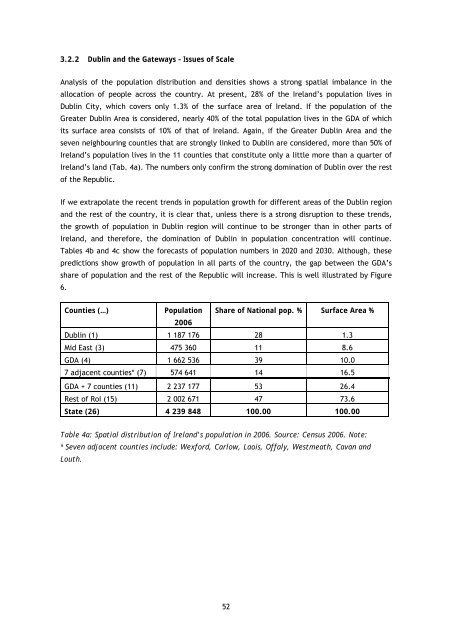TWICE THE SIZE - DIT Update - Dublin Institute of Technology
TWICE THE SIZE - DIT Update - Dublin Institute of Technology
TWICE THE SIZE - DIT Update - Dublin Institute of Technology
You also want an ePaper? Increase the reach of your titles
YUMPU automatically turns print PDFs into web optimized ePapers that Google loves.
3.2.2 <strong>Dublin</strong> and the Gateways – Issues <strong>of</strong> Scale<br />
Analysis <strong>of</strong> the population distribution and densities shows a strong spatial imbalance in the<br />
allocation <strong>of</strong> people across the country. At present, 28% <strong>of</strong> the Ireland’s population lives in<br />
<strong>Dublin</strong> City, which covers only 1.3% <strong>of</strong> the surface area <strong>of</strong> Ireland. If the population <strong>of</strong> the<br />
Greater <strong>Dublin</strong> Area is considered, nearly 40% <strong>of</strong> the total population lives in the GDA <strong>of</strong> which<br />
its surface area consists <strong>of</strong> 10% <strong>of</strong> that <strong>of</strong> Ireland. Again, if the Greater <strong>Dublin</strong> Area and the<br />
seven neighbouring counties that are strongly linked to <strong>Dublin</strong> are considered, more than 50% <strong>of</strong><br />
Ireland’s population lives in the 11 counties that constitute only a little more than a quarter <strong>of</strong><br />
Ireland’s land (Tab. 4a). The numbers only confirm the strong domination <strong>of</strong> <strong>Dublin</strong> over the rest<br />
<strong>of</strong> the Republic.<br />
If we extrapolate the recent trends in population growth for different areas <strong>of</strong> the <strong>Dublin</strong> region<br />
and the rest <strong>of</strong> the country, it is clear that, unless there is a strong disruption to these trends,<br />
the growth <strong>of</strong> population in <strong>Dublin</strong> region will continue to be stronger than in other parts <strong>of</strong><br />
Ireland, and therefore, the domination <strong>of</strong> <strong>Dublin</strong> in population concentration will continue.<br />
Tables 4b and 4c show the forecasts <strong>of</strong> population numbers in 2020 and 2030. Although, these<br />
predictions show growth <strong>of</strong> population in all parts <strong>of</strong> the country, the gap between the GDA’s<br />
share <strong>of</strong> population and the rest <strong>of</strong> the Republic will increase. This is well illustrated by Figure<br />
6.<br />
Counties (…) Population<br />
2006<br />
Share <strong>of</strong> National pop. % Surface Area %<br />
<strong>Dublin</strong> (1) 1 187 176 28 1.3<br />
Mid East (3) 475 360 11 8.6<br />
GDA (4) 1 662 536 39 10.0<br />
7 adjacent counties* (7) 574 641 14 16.5<br />
GDA + 7 counties (11) 2 237 177 53 26.4<br />
Rest <strong>of</strong> RoI (15) 2 002 671 47 73.6<br />
State (26) 4 239 848 100.00 100.00<br />
Table 4a: Spatial distribution <strong>of</strong> Ireland’s population in 2006. Source: Census 2006. Note:<br />
* Seven adjacent counties include: Wexford, Carlow, Laois, Offaly, Westmeath, Cavan and<br />
Louth.<br />
52








